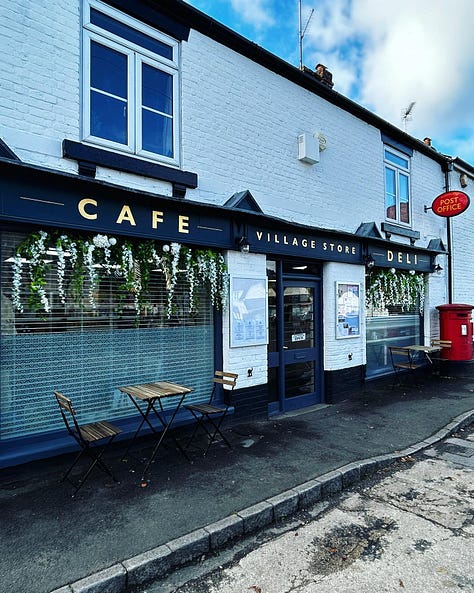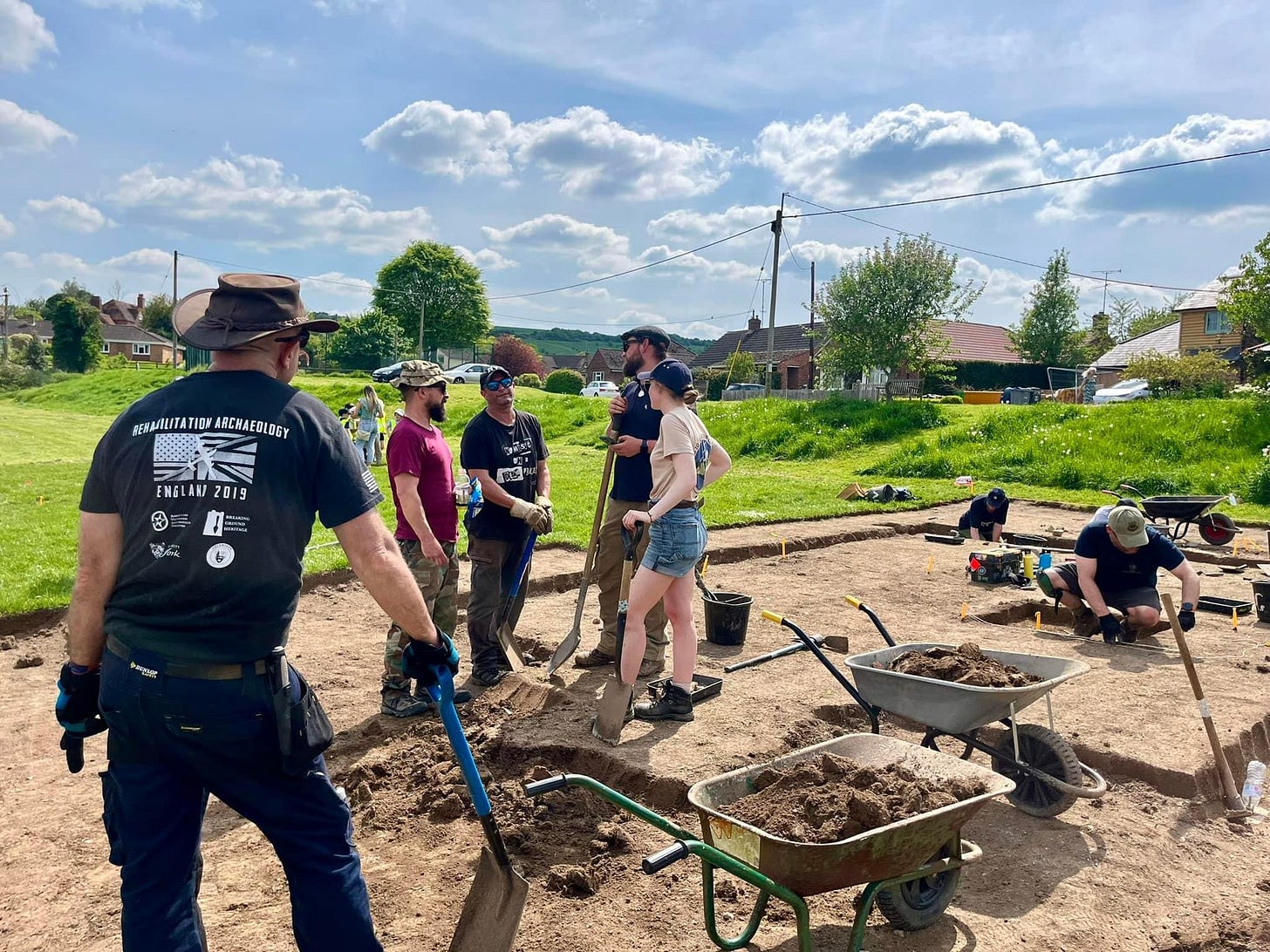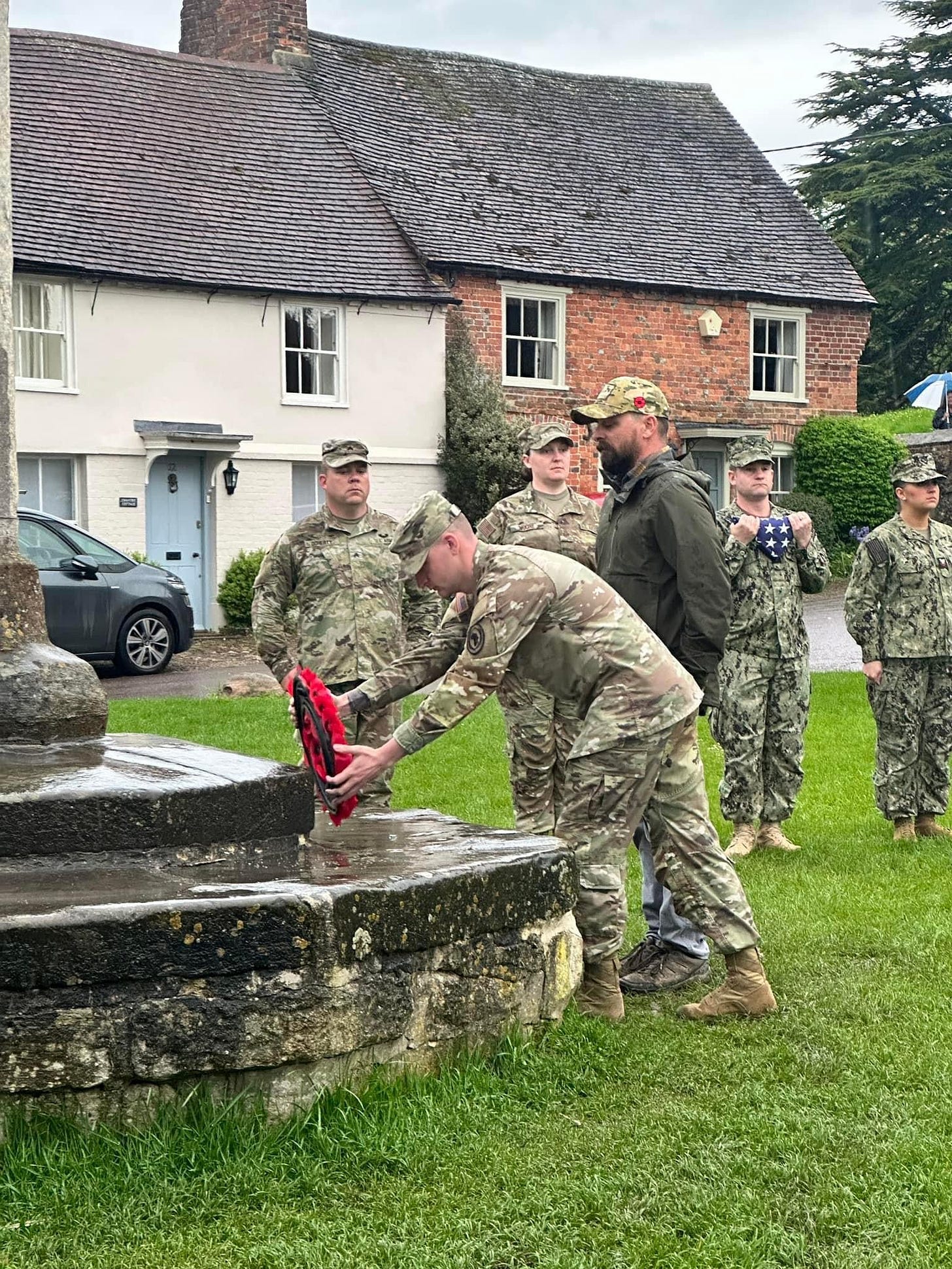Digging Band of Brothers
Digging into the excavation site in Wiltshire where the famous Easy, Dog, and Fox companies were stationed during World War II
Although it will be common knowledge to military history nerds, the fact that England once housed thousands of American Paratroopers during WWII comes as a surprise to many. These men trained in the U.S., then travelled by boat to England where they would end up in a variety of villages to continue to train and perfect their techniques before jumping from planes into France on D-Day. After D-Day fighting was concluded, the survivors would return to England for some rest, more training, and a few cheeky weddings to the English ladies, before their next jump into continental Europe for Operation Market Garden. They wouldn’t return to England during the war unless injured or on their way back to the states.
One of these training villages is the stunning, picture perfect town of Aldbourne, Wiltshire. With thatched roofs, a general store, and a grey stoned church overlooking a green, I wouldn’t be surprised to see Aldbourne in a “quintessential England” tourist calendar. It wouldn’t have looked much different in the 1940s, save a bit more camouflage, quite a few more army vehicles, and a bit more difficulty queueing for a pint at one of the local pubs.


The football pitch would have been the busy housing estate, with Nissen huts throughout, troops throwing baseballs around, and local girls visiting. These huts strike an extra note in modern day too, as they once housed members of the 101st Airborne division, such as the famous “Band of Brothers” Easy Company and “Fighting Fox” Fox Company.
It’s here on the football pitch that I spend a week digging with a team every May, finding heaps of artefacts over the years that tie us directly to these famous paratroopers.




The Dig Site: At least one Nissen hut on the now football pitch becomes the focus each year - we do our best to answer yearly research questions and find out where different Companies were stationed within the housing complex, not to mention (hopefully) find artefacts that can tell stories about the people who lived there. We methodically utilise geophysical technology prior to digging to locate the hut we will target, before removing and stacking turf. Then we slowly dig from the outside in, exposing first the post pads that created the foundation for the hut, before examining the insides of the hut (what would have been the floor). We dig with spades and shovels to remove large amounts of soil, and use trowels to examine and carefully locate finds.
There are also a team of metal detectorists that search the field each year, and astonishingly manage to locate new things in areas people have detected countless times. An empty Bren gun magazine was found this year near the loos!
Incredibly, there have been remnants of life found, from parachute pulls to jam jar lids to ladies stockings. It’s easy to sit on the field, right outside the front doors of where one of the Nissen huts used to be, and imagine the hustle and bustle, the noise, and the people. Every object feels so personal and (thanks to a lack of time) so familiar that you feel an immediate connection to the place, and it’s part of what makes digging a modern conflict site so special.
Digging Deeper: This dig is also unique in that there are archaeologists and volunteers on site, but the focus of the excavation is for veterans who are utilising archaeology to help their mental health. Working on a modern conflict site becomes extremely personal for them (more than an Iron Age site or a Roman site), because they find familiarity in all of the artefacts. (“Ahhh, I’ve got one of these bullets in my leg!”).
They are the finds experts, not to mention the historical geniuses who can rattle off any Band of Brothers info you might want. They might have PTSD, anxiety, or are missing limbs and struggling to find community… and this initiative helps them find meaning in their lives again. It’s through this initiative, called Operation Nightingale, that archaeological learning, camaraderie, dark dark humour, late nights at campfires, and afternoons with a pint, make healing happen.



Top Finds: There have been quite a few solid finds over the years, but if you ask everyone what the top find might be, they all have different answers. A parachute pull? A lid to a marmalade jar? How about ladies stockings? I found an old lipstick lid this year for a portable makeup kit and I was chuffed! What a spectacular find for me as I can immediately imagine life as a woman sneaking onto site — what WAS she up to!?


Now of course, there are finds, but then there are finds. You know, the ones that people talk about for years and make the news and are used as icebreakers on dates. This year, the star find went to a dog tag, nearly missed, that was rolled up and likely shoved between some floorboards when the owner was issued a new one. With the finding of Otto May’s dog tag, came research of Otto’s history, connecting with his living relatives, and eventually a zoom call to the East Coast of the US, where we saw Otto’s Uniform, scrapbooks and heard stories of his time in war. An absolutely gobsmacking experience.


Site Digs: You mix archaeology with veterans and without a doubt camping will be involved. While the RAF find it cosiest being put up in the local pub (I’m looking at you Dave), the majority of vets, archaeologists and volunteers set up camp on the football pitch. This year, we could open the front door of our lovely bell tent and see the site — no room for a work/life balance here! Although it may seem a bit extra to have a bell tent on a site, its probably towards a more accurate set up for what someone may have seen in the area during WWII. We know that a portion of the field had tents, and that they were simple to put up, withstanding rain and wind. Not far off, I’d say! However, these tents are not solid enough to fend off snoring… in case anyone was curious.
Dig grub: While the archaeology is the main meal of this mental wellbeing dig, the sips and the grub are the side dishes to really complete the vibe. Over the years we’ve had pints and Morris Dancing at The Blue Boar (where the Officers used to drink), delicious Scotch eggs from the village store (Winters and Welsh stayed in the room above the word ‘cafe’), and Chinese in the town hall (where the 101st danced so hard for so many months that they ended up buying a new floor for the village when they left). We’ve all given Lardy Cake a try — it’s not for me — and have spent dig days awaiting the next cake delivery from a local. It feels a bit like the Great British Bake Off and that everyone wants us to judge the cakes to figure out who’s is best, but we wouldn’t dare disrupt the order of things and have any potential at less cakes the following year.
We’ve had vets pop behind the bar to pour a drink and I had a bartender one year hand me a carton of freshly laid eggs from her chickens. One of my favourite stories however, was the absolute shock on his face when an American heard ‘Aspall’s’ cyder pronounced for the first time, splitting the word into two crude A** B**ls, and the village hasn’t been the same since. Everybody calls it that now.






Trowels down: As with any poignant dig, it’s important to remember the fallen. We dig to help veterans, to teach volunteers, and to recover any history of those who lived here - some of whom may have given their lives. The photo below shows six men and women, all American, either serving or veterans, who have come along the past two years to help us in our efforts and to help themselves with recovery and archaeological learning. The chap standing tall in a green jacket is a 101st Airborne Division veteran, so this dig means something extra to him and it’s always a pleasure to have him with us.
The ceremony is solemn, but full of pride.
Here’s to 2025! Currahee!!
To learn more: Harvey Mills took the professional photographs in this post, and we are so lucky to have him be a part of Operation Nightingale digs because he depicts an archaeological site to its fullest - dirt, sweat, tears, and friendship. To find more of his photographs go to harveymills.com.
To learn more about the site, visit the Ministry of Defence website here, watch a two part documentary on History Hit TV here, find us on History Hit Youtube here, or Time Team Official here - with a new Time Team special coming soon!





